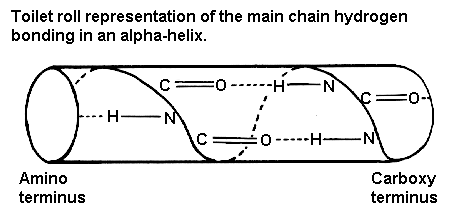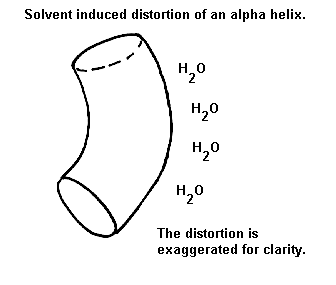Alpha-Helix Geometry Part. 2
Back to Index
Properties of the alpha-helix.
- The structure repeats itself every 5.4 Angstroms along the helix axis, ie we say that the alpha-helix has a pitch of 5.4 Angstroms. Alpha-helices have 3.6 amino acid residues per turn, ie a helix 36 amino acids long would form 10 turns. The separation of residues along the helix axis is 5.4/3.6 or 1.5 Angstroms, ie the alpha-helix has a rise per residue of 1.5 Angstroms.
- Every mainchain C=O and N-H group is hydrogen-bonded to a peptide bond 4 residues away (ie O(i) to N(i+4)). This gives a very regular, stable arrangement.
- The peptide planes are roughly parallel with the helix axis and the dipoles within the helix are aligned, ie all C=O groups point in the same direction and all N-H groups point the other way. Side chains point outward from helix axis and are generally oriented towards its amino-terminal end.

- All the amino acids have negative phi and psi angles, typical values being -60 degrees and -50 degrees, respectively.
Distortions of alpha-helices.
The majority of alpha-helices in globular proteins are curved or distorted somewhat compared with the standard Pauling-Corey model. These distortions arise from several factors including:
- The packing of buried helices against other secondary structure elements in the core of the protein.
- Proline residues induce distortions of around 20 degrees in the direction of the helix axis. This is because proline cannot form a regular alpha-helix due to steric hindrance
arising from its cyclic side chain which also blocks the main chain N atom and chemically prevents it forming a hydrogen bond. Janet Thornton has shown that proline causes two H-bonds in the helix to be broken since the NH group of the following residue is also prevented from forming a good hydrogen bond. Helices containing proline are usually long perhaps because shorter helices would be destabilised by the presence of a proline residue too much. Proline occurs more commonly in extended regions of polypeptide.
- Solvent. Exposed helices are often bent away from the solvent region. This is because the exposed C=O groups tend to point towards solvent to maximise their H-bonding capacity, ie tend to form H-bonds to solvent as well as N-H groups. This gives rise to a bend in the helix axis.

- 3(10)-Helices. Strictly, these form a distinct class of helix but they are always short
and frequently occur at the termini of regular alpha-helices. The name 3(10) arises because
there are three residues per turn and ten atoms enclosed in a ring formed by each hydrogen
bond (note the hydrogen atom is included in this count). There are main chain hydrogen bonds
between residues separated by three residues along the chain (ie O(i) to N(i+3)). In this
nomenclature the Pauling-Corey alpha-helix is a 3.6(13)-helix. The dipoles of the 3(10)-helix
are not so well aligned as in the alpha-helix, ie it is a less stable structure and side chain
packing is less favourable.
Here's a coordinate file for a single turn of
3-10 helix, which
you may examine with RasMol.

Back to the Top
j.cooper 2/1/95



